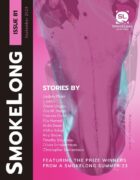At the heart of “Tiger House” for me is the love the narrator feels for her elderly mother. She does everything she can to protect her and keep her safe. Recently, stories about caring for elderly parents have become more prominent in the literary world. What inspired you to write this one?
There’s a real tiger house in San Francisco that I walked by almost every day of my childhood, so I started this piece as an imagined origin story for that house. For me, writing a story often feels like collaging together memories and feelings until I create something new, so it’s difficult to pinpoint exactly what inspired the relationship between the narrator and her elderly mother. I think the elderly mother was largely inspired by my grandpa who passed away from a stroke a couple of years ago. He lost his ability to communicate pretty quickly while in the hospital, and his last words were “give me the goodies” (referring to sweets). There was something strange and sad and sort of sweet about this childlike reversion he experienced in the end.
Likening Mama to a toddler and a feral cat are powerful images that seem like they should cause cognitive dissonance, but the reader intuitively grasps what you are trying to convey. How did you arrive at these revelations?
For this story, I wanted to explore connection and communication through the loss of language, so I think the child and animal imagery fell into place naturally because of the ways children and animals communicate nonverbally. I spend much of my day trying to communicate with my dog despite the fact that we don’t speak the same language, yet somehow, we seem to understand each other on some fundamental level.
From painting the house yellow, to crafting duct tape flowers, to hanging glittery green curtains, to finally painting a tiger mural, does the narrator instinctively know that art and color will reach her mother or was it something she learned?
I was raised by two creative parents, and my brother is an artist, so art has always been a point of connection for my family. One of my mom’s pandemic hobbies was duct tape art, and once, when I visited her in LA for a week, we sat together silently for an afternoon cutting flowers out of duct tape and sticking them to her patio furniture. I’ve always really appreciated her ability to find creative opportunities in seemingly lackluster, everyday objects. I imagine that, like me, the narrator understands that art is something she can turn to for connection with her mom.
I have found that it feels a lot like walking a tightrope when embedding other languages into flash. Did you find it a challenge incorporating French into your narrative? Each choice feels necessary, especially when we come to your carefully crafted ending.
I was actually surprised by how easily French found its way into the story because I’m not a French speaker. My grandpa was, though, and I definitely drew a lot of inspiration from him for this story.
Finally, I saw on your website that you are working on a short story collection based on the San Francisco Bay Area. I would love to hear more about it!
It’s still very much in the works, but it’s starting to take the form of a collection of flash fiction set in the Haight-Ashbury neighborhood of San Francisco where I grew up. I moved to Massachusetts for graduate school last year, so I’ve been trying to turn my homesickness into something productive!



 The SmokeLong Grand Micro Contest (The Mikey) is now an annual competition celebrating and compensating the best micro fiction and nonfiction online.
The SmokeLong Grand Micro Contest (The Mikey) is now an annual competition celebrating and compensating the best micro fiction and nonfiction online.